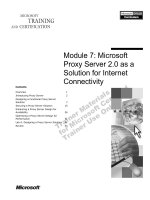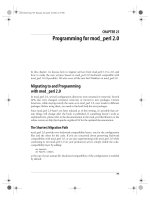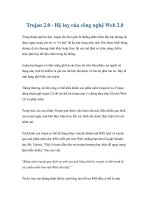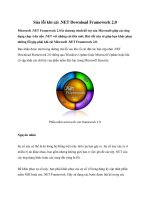Praise for Learning Objective-C 2.0 potx
Bạn đang xem bản rút gọn của tài liệu. Xem và tải ngay bản đầy đủ của tài liệu tại đây (5.31 MB, 407 trang )
ptg
www.it-ebooks.info
ptg
Praise for Learning Objective-C 2.0
“With Learning Objective-C 2.0, Robe r t Clair cuts r ight to the chase and pro-
vides not only comprehensive coverage of Objective-C, but also time-saving
and headache-preventing insights drawn from a depth of real world, hands-on
experience. The combination of concise overview, examples, and specific
implementation details allows for rapid, complete, and well-rounded under-
standing of the language and its core features and concepts.”
—Scott D. Yelich, Mobile Application Developer
“There are a number of books on Objective-C that attempt to cover the
entire gamut of object-oriented programming, the Objective-C computer lan-
guage, and application development on Apple platforms. Such a range of topics
is far too ambitious to be covered thoroughly in a single volume of finite size.
Bob Clair’s book is focused on mastering the basics of Objective-C, which will
allow a competent programmer to begin writing Objective-C code.”
—Joseph E. Sacco, Ph.D., J.E. Sacco & Associates, Inc.
“Bob Clair’s Learning Objective-C 2.0 is a masterfully crafted text that provides
in-depth and interesting insight into the Objective-C language, enlightening
new programmers and seasoned pros alike. When programmers new to the lan-
guage ask about where they should start, this is the book I now refer them to.”
—Matt Long, Cocoa Is My Girlfriend (www.cimgf.com)
“Robert Clair has taken the Objective-C language and presented it in a way
that makes it even easier to learn. Whether you’re a novice or professional pro-
grammer, you can pick up this book and begin to follow along without know-
ing C as a prerequisite.”
—Cory Bohon, Indie Developer and Blogger for Mac|Life
“I like this book because it is technical without being dry, and readable with-
out being fluffy.”
—Andy Lee, Author of AppKiDo
www.it-ebooks.info
ptg
This page intentionally left blank
www.it-ebooks.info
ptg
Learning
Objective-C 2.0
www.it-ebooks.info
ptg
This page intentionally left blank
www.it-ebooks.info
ptg
Learning
Objective-C 2.0
A Hands-On Guide to Objective-C
for Mac and iOS Developers
Robert Clair
Upper Saddle River, NJ • Boston • Indianapolis • San Francisco
New York • Toronto • Montreal • London • Munich • Paris • Madrid
Capetown • Sydney • Tokyo • Singapore • Mexico City
Download from www.wowebook.com
www.it-ebooks.info
ptg
Editor-in-Chief
Karen Gettman
Senior Acquisitions
Editor
Chuck Toporek
Managing Editor
John Fuller
Project Editor
Anna Popick
Copy Editor
Kelli Brooks
Indexer
Jack Lewis
Proofreader
Debbie Liehs
Technical
Reviewers
Joachim Bean
Cory Bohon
Andy Lee
Matt Long
Joseph E. Sacco,
Ph.D.
Scott D. Yelich
Editorial Assistant
Romny French
Compositor
Rob Mauhar
Cover Designer
Chuti Prasertsith
Many of the designations used by manufacturers and sellers to distinguish their products
are claimed as trademarks. Where those designations appear in this book, and the pub-
lisher was aware of a trademark claim, the designations have been printed with initial capi-
tal letters or in all capitals.
The author and publisher have taken care in the preparation of this book, but make no
expressed or implied warranty of any kind and assume no responsibility for errors or omis-
sions. No liability is assumed for incidental or consequential damages in connection with or
arising out of the use of the information or programs contained herein.
The publisher offers excellent discounts on this book when ordered in quantity for bulk pur-
chases or special sales, which may include electronic versions and/or custom covers and
content particular to your business, training goals, marketing focus, and branding interests.
For more information, please contact:
U.S. Corporate and Government Sales
(800) 382-3419
For sales outside the United States please contact:
International Sales
Visit us on the Web: informit.com/aw
Library of Congress Cataloging-in-Publication Data
Clair, Robert, 1950–
Learning Objective-C 2.0 : a hands-on guide to Objective-C for Mac and iOS developers /
Robert Clair.
p. cm.
Includes index.
ISBN-13: 978-0-321-71138-0 (pbk. : alk. paper)
ISBN-10: 0-321-71138-6 (pbk. : alk. paper)
1. Objective-C (Computer program language) 2. Object-oriented programming (Computer
science) 3. Macintosh (Computer)—Programming. 4. iPhone (Smartphone)—Programming.
I. Title.
QA76.73.O115C58 2011
005.1'17—dc22
2010019360
Copyright © 2011 Pearson Education, Inc.
All rights reserved. Printed in the United States of America. This publication is protected by
copyright, and permission must be obtained from the publisher prior to any prohibited repro-
duction, storage in a retrieval system, or transmission in any form or by any means, elec-
tronic, mechanical, photocopying, recording, or likewise. For information regarding
permissions, write to:
Pearson Education, Inc.
Rights and Contracts Department
501 Boylston Street, Suite 900
Boston, MA 02116
Fax: (617) 671-3447
ISBN-13: 978-0-321-71138-0
ISBN-10: 0-321-71138-6
Text pr i nte d in th e Un i te d St a te s on re c ycl ed pape r at RR Don n el l ey in Cr awf o rd s vi l le, In di a na.
First printing, July 2010
Download from www.wowebook.com
www.it-ebooks.info
ptg
❖
To t h e m e mor y o f my p a re n t s,
Selma B. and Martin H. Clair,
and to Ekko
❖
Download from www.wowebook.com
www.it-ebooks.info
ptg
This page intentionally left blank
Download from www.wowebook.com
www.it-ebooks.info
ptg
Contents at a Glance
Preface xxiii
Acknowledgments xxxi
About the Author xxxiii
I: Introduction to Objective-C 1
1 C, The Foundation of Objective-C 3
2 More About C Variables 41
3 An Introduction to Object-Oriented Programming 55
4 You r F irs t Ob je ctive -C Prog ra m 73
II: Language Basics 91
5 Messaging 93
6 Classes and Objects 115
7 The Class Object 143
8 Frameworks 159
9 Common Foundation Classes 171
10 Control Structures in Objective-C 191
11 Categories, Extensions, and Security 213
12 Properties 229
13 Protocols 249
III: Advanced Concepts 265
14 Reference Counting 267
15 Garbage Collection 291
16 Blocks 309
Download from www.wowebook.com
www.it-ebooks.info
ptg
x
Contents at a Glance
IV: Appendices 335
A Reserved Words and Compiler Directives 337
B Tol l- Free Br idge d C lass es 339
C 32- and 64-Bit 341
D Runtimes, Old and New 345
E Resources for Objective-C 349
Index 351
Download from www.wowebook.com
www.it-ebooks.info
ptg
Contents
Preface xxiii
Acknowledgments xxxi
About the Author xxxiii
I: Introduction to Objective-C 1
1 C, The Foundation of Objective-C 3
The Structure of a C Program 4
main Routine 4
Formatting 5
Comments 5
Variable and Function Names 6
Naming Conventions 6
Files 7
Variables 8
Integer Types 8
Floating-Point Types 9
Tr uth Va lue s 9
Initialization 10
Pointers 10
Arrays 12
Strings 13
Structures 14
typedef 15
Enumeration Constants 15
Operators 16
Arithmetic Operators 16
Remainder Operator 16
Increment and Decrement Operators 16
Precedence 17
Negation 18
Comparisons 18
Logical Operators 18
Logical Negation 19
Download from www.wowebook.com
www.it-ebooks.info
ptg
xii
Contents
Assignment Operators 19
Conversion and Casting 19
Other Assignment Operators 20
Expressions and Statements 21
Expressions 21
Evaluating Expressions 21
Statements 22
Compound Statements 22
Program Flow 22
if 23
Conditional Expression 24
while 24
do-while 25
for 25
break 26
continue 26
Comma Expression 27
switch 27
goto 28
Functions 29
Declaring Functions 31
Preprocessor 31
Including Files 31
#define 32
Conditional Compilation 32
printf 33
Using gcc and gdb 35
Summary 37
Exercises 37
2 More About C Variables 41
Memory Layout of an Objective-C Program 41
Automatic Variables 42
External Variables 43
Declaration Keywords 44
auto 44
extern 45
Download from www.wowebook.com
www.it-ebooks.info
ptg
xiii
Contents
static 45
register 46
const 46
volatile 47
Scope 47
The Scope of Automatic Variables 47
Compound Statements and Scope 48
The Scope of External Variables 49
Dynamic Allocation 49
Summary 51
Exercises 52
3
An Introduction to Object-Oriented Programming 55
Object-Oriented Programming 55
Classes and Instances 56
Methods 56
Encapsulation 56
Inheritance 57
Polymorphism 58
What Is the Point of an Object-Oriented
Language? 58
An Introduction to Objective-C 58
Defining a Class 59
Class Names as Types 61
Messaging (Invoking a Method) 62
Class Objects and Object Creation 64
Memory Management 65
Objective-C Additions 66
Runtime 66
Names 66
Message Expressions 66
Compiler Directives 67
Literal Strings 67
Objective-C Keywords 67
Cocoa Numeric Types 70
NSLog 70
Summary 71
Download from www.wowebook.com
www.it-ebooks.info
ptg
xiv
Contents
4 Your Fir st Objective-C Program 73
Building with Xcode 73
Objective-C Program Structure 76
Build and Run the Program 78
An Object-Oriented Hello World 79
Greeter.h 80
Greeter.m 82
HelloObjectiveC.m 86
Build and Run the Program 87
Summary 88
Exercises 88
II: Language Basics 91
5 Messaging 93
Methods 93
A Simple Method 93
Methods with Arguments 94
Messaging 96
Polymorphism 97
Messaging Details 98
Nesting 98
Messaging
nil 100
Sending Messages to self 100
Overriding and Messages to super 101
Selectors 103
Method with the Same Name 104
Dynamic and Static Typing 105
Under the Hood 106
Message Forwarding 108
Efficiency 109
Introspection and Other Runtime Fun 111
Summary 112
Exercises 113
6
Classes and Objects 115
Defining a Class 115
Download from www.wowebook.com
www.it-ebooks.info
ptg
xv
Contents
The Interface Section 115
@class Directive 117
The Implementation Section 117
Imports 118
Subclassing a Class 119
Defining a Subclass 119
An Example of Subclassing 119
Class Hierarchies 123
A Class Hierarchy Example 124
Abstract Classes 125
Creating Objects 126
Object Allocation 126
Object Initialization 127
Destroying Objects 135
Copying Objects 136
Shallow and Deep Copies 137
Mutable and Immutable Copies 138
Implementing Copying in Your Own Classes 139
Summary 141
Exercises 141
7
The Class Object 143
Class Objects 143
The Class Type 144
Class Methods 146
Other Class Methods 147
Convenience Constructors 147
Singletons 149
Initializing Classes 150
Mimicking Class Variables 151
Summary 157
Exercises 157
8
Frameworks 159
What Is a Framework? 159
Using a Framework 160
Cocoa Frameworks 161
iPhone 162
Download from www.wowebook.com
www.it-ebooks.info
ptg
xvi
Contents
AppKit 162
Core Foundation 163
Memory Management for Core Foundation
Objects 164
Tol l-Fr ee Br idg ing 165
Core Graphics 166
Core Animation 167
Other Apple-Supplied Frameworks 167
Third-Party Frameworks 168
Under the Hood 168
Summary 170
9 Common Foundation Classes 171
Immutable and Mutable Classes 171
Class Clusters 172
NSString 173
NSString Examples 174
C String to NSString and Back 176
NSMutableString 176
Literal Strings 177
Collection Classes 177
NSArray 177
NSDictionary 180
NSSet 182
NSNumber 183
NSNull 184
NSData 185
Accessing NSData’s B yt e s 185
File to NSData and Back 186
NSURL 186
Structures 187
Summary 188
Exercises 189
10 Control Structures in Objective-C 191
if Statements 191
Tes tin g Ob je cts fo r Eq ua lit y 193
Download from www.wowebook.com
www.it-ebooks.info
ptg
xvii
Contents
for Statements and Implicit Loops 195
for Statements 195
Implicit Loops 195
Implicit Loops with Blocks 196
while Statements and NSEnumerator 196
Modifying a Mutable Collection While
Enumerating 197
Fast Enumeration 199
An Example Using Fast Enumeration 201
Exceptions 205
Throwing Your Own Exceptions 206
Multiple
@catch Blocks 207
Nested Exception Handling 207
Using Exceptions 208
Should You Use Exceptions? 209
Summary 210
Exercises 211
11 Categories, Extensions, and Security 213
Categories 213
Overriding Methods with Categories 216
Other Uses for Categories 217
Extensions 218
Instance Variable Scope (Access Control) 220
Access Control for Methods 221
Namespaces 221
Security 222
Calling C Functions from Objective-C 224
Tec hni cal 225
Practical 225
Philosophical 225
Summary 226
Exercises 226
12
Properties 229
Accessing Instance Variables Outside of an Object
(Don’t Do It) 230
Download from www.wowebook.com
www.it-ebooks.info
ptg
xviii
Contents
Declaring and Implementing Accessors 231
The Form of Accessors 232
Accessors Using Properties 233
The Instance Variable Name Can Be Different from
the Property Name 235
The @property Statement 236
assign, retain, copy 236
readwrite, readonly 237
nonatomic 237
setter=name, getter=name 237
attributes and @dynamic 238
More About @dynamic 238
Properties and Memory Management 240
dealloc 240
Subclassing and Properties 240
Hidden Setters for readonly Properties 242
Properties as Documentation 242
Dot Syntax 243
Dot Syntax and Properties 244
Dot Syntax and C structs 245
Summary 246
Exercises 247
13 Protocols 249
Protocols 249
Using Protocols 250
Declaring a Protocol 250
Adopting a Protocol 251
Protocols as Types 252
Properties and Protocols 252
TablePrinter Example 253
TablePrinterDataSource 253
TablePrinter 254
FruitBasket 256
main 258
A Problem 259
Implement the Optional Methods 260
Download from www.wowebook.com
www.it-ebooks.info
ptg
xix
Contents
Protocol Objects and Testing for Conformance 260
Informal Protocols 261
Summary 262
Exercises 263
III: Advanced Concepts 265
14 Reference Counting 267
The Problem 268
Reference Counting 269
Receiving Objects 271
Ownership 273
Tak ing Ow ner sh ip by C opyi ng 274
dealloc 274
Returning Objects 276
Autorelease 277
Autorelease Pools 277
Managing Autorelease Pools 278
Back to Convenience Constructors 280
Autorelease and the iPhone 280
Using Extra Autorelease Pools to Control Memory
Usage 280
retainCount 281
Multithreading 282
When Retain Counts Go Bad 283
NSZombie 284
Retain Cycles 285
The Final Goodbye: When Programs Terminate 288
Summary 288
Exercises 289
15 Garbage Collection 291
Garbage Collection: The Theory 291
Garbage Collection: The Practice 293
Strong and Weak References 293
Using Garbage Collection 294
Controlling When Collections Occur 296
Download from www.wowebook.com
www.it-ebooks.info
ptg
xx
Contents
Finalizers 296
malloc and Garbage Collection 297
Core Foundation Objects and Garbage Collection 298
Some Bumps in the Road 299
Opaque Pointer Problems in the AppKit 299
Interior Pointers 302
Falsely Rooted Objects 303
Garbage Collection Pro and Con 303
The Positive 304
The Negative 304
Should You Use Garbage Collection? 304
Summary 305
Exercises 305
16 Blocks 309
Function Pointers 310
Calling a Function with a Function Pointer 311
Using Function Pointers 312
The Trouble with Function Pointers 314
NSInvocation 315
Blocks 317
Block Pointers 318
Access to Variables 319
Block Variables 320
Blocks Are Stack Based 321
Global Blocks 322
Blocks Are Objective-C Objects 322
Copying Blocks 323
Memory Management for Blocks 323
Tra ps 326
Blocks in Cocoa 327
Style Issues 330
Some Philosophical Reservations 331
Summary 332
Exercises 332
Download from www.wowebook.com
www.it-ebooks.info
ptg
xxi
Contents
IV: Appendices 335
A Reserved Words and Compiler Directives 337
B Toll-Free Bridged Classes 339
C 32- and 64-Bit 341
Kernel and User Programs in 64-Bit 342
Coding Differences for 64-Bit Programs 342
Performance 342
Compiling for 64-Bit 343
More Information 343
D Runtimes, Old and New 345
Synthesized Instance Variables 345
Synthesized Instance Variables and Mac OS X
Leopard (v 10.5) 346
The Fragile Base Class Problem—Solved 347
E Resources for Objective-C 349
Apple Resources 349
Internet Resources 350
Groups 350
Books 350
Index 351
Download from www.wowebook.com
www.it-ebooks.info
ptg
This page intentionally left blank
Download from www.wowebook.com
www.it-ebooks.info
ptg
Preface
Objective-C is an object-oriented extension to C. You could call it “C with Objects.”
If you’re reading this book, you’re probably interested in learning Objective-C so that
you can write applications for Mac OS X or for iOS. But there’s another reason to learn
Objective-C: It’s a fun language and one that is relatively easy to learn. Like anything
else in the real world, Objective-C has some rough spots, but on the whole it is a much
simpler language than other object-oriented languages, particularly C++. The additions
that Objective-C makes to C can be listed on a page or two.
In the Apple world, Objective-C does not work alone. It is used in conjunction with
two class libraries called frameworks. Th e Foundation framework c on ta ins classes for ba si c
entities, such as strings and arrays, and classes that wrap interactions with the operating
system. The AppKit contains classes for windows, views, menus, buttons, and the assorted
other widgets needed to build graphical user interfaces. Together, the two frameworks are
called Cocoa. On iOS, a different framework called the UIKit replaces the AppKit.
To g e t h e r , F o u n d a t i o n a n d U I K i t a r e c a l l e d C o c o a To u c h .
Objective-C was initially created by Brad J. Cox in the early 1980s. In 1988, NeXT
Computer, the company started by Steve Jobs after he left Apple, licensed Objective-C
and made it the basis of the development environment for creating applications to run
under NeXT’s NeXTSTEP operating system. The NeXT engineers developed a set of
Objective-C libraries for use in building applications. After NeXT withdrew from the
hardware business in 1993, it worked with Sun Microsystems to create OpenStep, an open
specification for an object-oriented system, based on the NeXTSTEP APIs. Sun eventually
lost interest in OpenStep. NeXT continued selling its version of OpenStep until NeXT
was purchased by Apple in early 1997. The NeXTSTEP operating system became the
basis of Mac OS X. The NeXT Objective-C libraries became the basis of Cocoa.
This book concentrates on the Objective-C language. It will not teach you how to
write Cocoa programs or make you an expert Xcode user. It covers and makes use of a
small part of the Foundation framework, and mentions the AppKit and UIKit only in
passing. The book’s premise is that you will have a much easier time learning Cocoa if
you first acquire a good understanding of the language on which Cocoa is based.
Who Should Read This Book
This book is intended for programmers who want to learn Objective-C in order to
write programs for Mac OS X or iOS. (iOS is used for the iPhone, the iPod touch, and
the iPad.) Although it is technically possible to write complete OS X programs using
Download from www.wowebook.com
www.it-ebooks.info
ptg
other languages, writing a program that follows the Apple Human Interface Guidelines
1
and has a proper Mac “look and feel” requires the use of the Objective-C Cocoa frame-
works. Even if you write the core of a Mac application in a different language, such as
plain C or C++, your user interface layer should be written in Objective-C. When writ-
ing for iOS, there is no choice: An iPhone app’s outer layer and user interface must be
written in Objective-C.
The book will also be useful for programmers who want to write Objective-C pro-
grams for other platforms using software from the GNUStep project,
2
an open source
implementation of the OpenStep libraries.
What You Need to Know
This book assumes a working knowledge of C. Objective-C is an extension of C; the
book concentrates on what Objective-C adds to C. For those whose C is rusty and
those who are adept at picking up a new language quickly, Chapters 2 and 3 form a
review of the essential parts of C, those that you are likely to need to write an
Objective-C program. If you have no experience with C or any C-like language (C++,
Java, and C#), you will probably want to read a book on C in conjunction with this
book. Previous exposure to an object-oriented language is helpful but not absolutely
necessary. The required objected-oriented concepts are introduced as the book proceeds.
New in Objective-C 2.0
If you already know some Objective-C and want to skip to the parts of the language
that are new in the 2.0 version, they are covered in these chapters:
n
Fast Enumeration (Chapter 10) provides a simple (and fast) way to iterate over a
collection of objects.
n
Declared properties (Chapter 12) provide an easy way to specify an object’s instance
variables and to have the compiler create methods to access those variables for you.
n
Garbage collection (Chapter 15) adds automatic memory management to Objective-
C.
n
Blocks (Chapter 16) let you define function-like objects that carry their context
with them.
How This Book Is Organized
This book is organized into three sections: The first section is a review of C, followed by
an introduction to object-oriented programming and Objective-C. The second section
of the book covers the Objective-C language in detail, and provides an introduction to
xxiv
Preface
1.
AppleHIGuidelines
2. www.gnustep.org
Download from www.wowebook.com
www.it-ebooks.info









